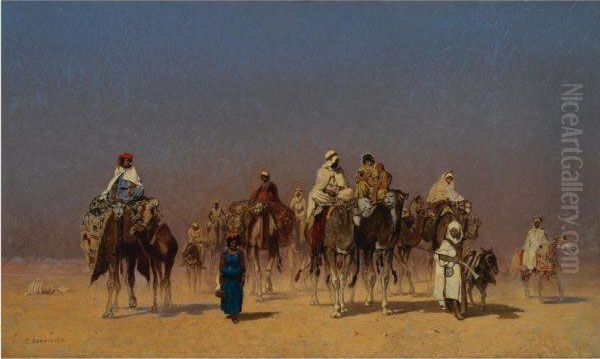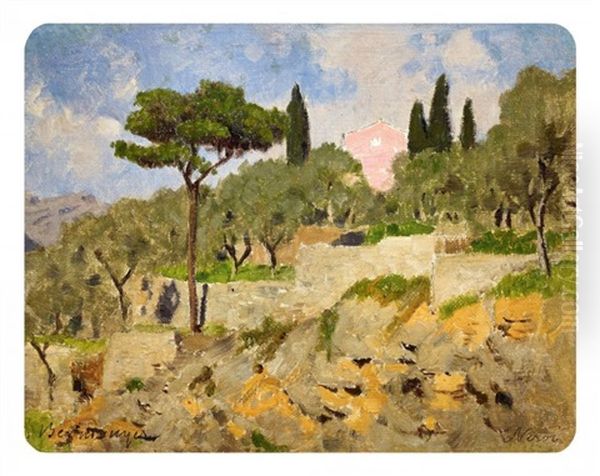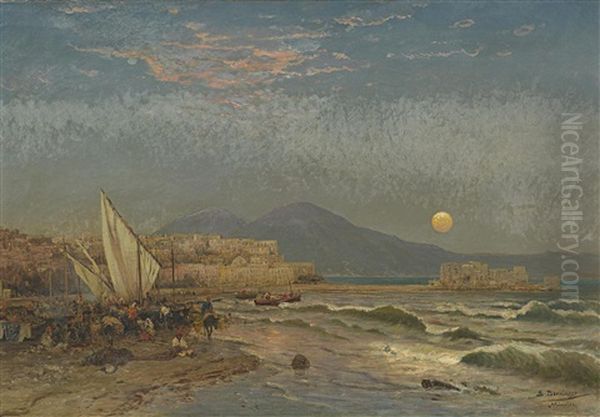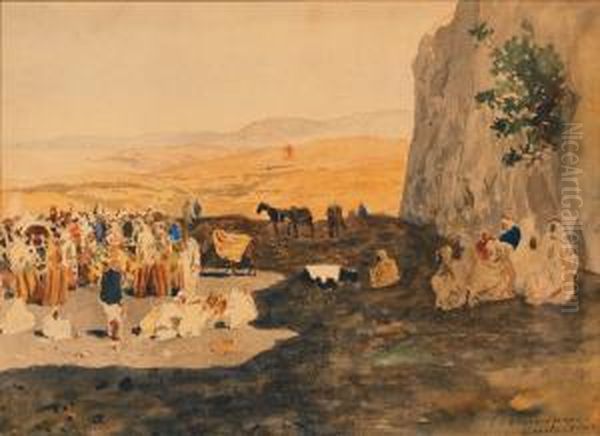Edmund Berninger stands as a fascinating figure within the diverse landscape of 19th-century German art. Born in Arnstadt, Thuringia, in 1843, and passing away in 1909, his artistic career traced a path from the heart of Germany to the sun-drenched shores of the Mediterranean and the bustling cities of the Near East. Primarily celebrated as a landscape and architectural painter, Berninger captured the spirit of his time, reflecting both the enduring tradition of German landscape painting and the burgeoning European fascination with exotic locales, often termed Orientalism. His journey from an apothecary apprentice to a widely traveled and exhibited artist reveals a dedication to observation and a keen eye for the picturesque, leaving behind a body of work that continues to intrigue art historians and collectors alike.
From Pharmacy to Palette: Early Life and Artistic Formation
Berninger's path to becoming an artist was not a direct one. Initially, he pursued a career seemingly far removed from the world of canvases and pigments, training as a pharmacist. This practical grounding, however, eventually gave way to a stronger calling. The allure of art proved irresistible, and in 1870, Berninger made the decisive shift, embarking on formal artistic training. His journey began at the esteemed Weimar Saxon Grand Ducal Art School, a significant centre for artistic innovation in Germany at the time.
In Weimar, Berninger had the crucial opportunity to study under Theodor Hagen (1842-1919). Hagen was a prominent figure in German landscape painting, known for his move towards a more realistic, plein-air inspired approach, influenced partly by the Barbizon School in France. Studying with Hagen would have exposed Berninger to contemporary trends in landscape art, emphasizing direct observation of nature and the subtle effects of light and atmosphere. This foundational period in Weimar undoubtedly shaped his early artistic sensibilities and technical skills.

Seeking further development and exposure to different artistic currents, Berninger moved to Munich in 1874. Munich was another major hub of artistic activity in 19th-century Germany, home to the influential Munich Academy and a thriving community of artists. While specific details of his studies there are less documented, the city's artistic environment, known for its strong tradition in history painting under figures like Karl von Piloty (1826-1886) but also a growing school of Realism and landscape painting perhaps influenced by artists like Wilhelm von Diez (1839-1907), would have provided further stimulus. It was during the 1870s, following his time in Weimar and Munich, that Berninger began to truly dedicate himself to landscape painting, the genre that would define his career.
Capturing the Homeland and Venturing Abroad: European Landscapes
Initially, Edmund Berninger focused his artistic attention on the landscapes of his native Germany. These early works likely reflected the training he received, particularly the emphasis on naturalism learned under Theodor Hagen. He would have honed his skills depicting the forests, rivers, and rolling hills characteristic of the German countryside, learning to capture the specific quality of light and atmosphere of his homeland. This grounding in familiar territory provided a solid foundation for his later explorations of more distant and varied terrains.
However, Berninger's artistic curiosity soon extended beyond Germany's borders. Like many artists of his era, he embarked on travels that significantly broadened his horizons and subject matter. His journeys took him across Europe, providing fresh inspiration and diverse motifs. He spent time in Great Britain, capturing scenes likely including the bustling urban landscape of London, a city undergoing immense transformation and expansion during the Victorian era. The unique atmospheric conditions of Britain, often characterized by mist and diffused light, would have presented different challenges and opportunities compared to the clearer continental light.
His travels also included the Netherlands, a country with a rich tradition of landscape and cityscape painting dating back to the Dutch Golden Age masters like Jacob van Ruisdael (c. 1629-1682) and Johannes Vermeer (1632-1675). Berninger would have encountered flat landscapes dominated by expansive skies, intricate canal systems, and distinctive architecture, offering a contrast to the topography of Germany or Britain. France, another destination, was the epicentre of major artistic movements, including Impressionism, which was gaining momentum during Berninger's active years. While Berninger largely retained a more realistic style, exposure to French art and landscapes may have subtly influenced his palette or compositional choices.

Italy, however, held a particular allure, as it did for generations of Northern European artists before him, including figures like Oswald Achenbach (1827-1905), known for his vibrant depictions of Italian life and landscapes. Berninger was drawn to the Mediterranean light and the historical resonance of the Italian peninsula. He produced numerous paintings of Venice, capturing its iconic canals, architecture, and unique maritime atmosphere. Works such as Golfo di Napoli (Bay of Naples), dated 1890 and now held in the Dresden State Art Collections, and Die Küste von Sorrent (The Coast of Sorrento), exhibited in Dresden in 1882, attest to his fascination with southern Italy. These Italian scenes allowed him to explore brighter light, warmer colours, and the interplay of land, sea, and ancient structures.
The Lure of the Orient: Journeys to North Africa and the Levant
Beyond his European travels, Edmund Berninger was deeply drawn to the landscapes, cultures, and architecture of North Africa and the Near East. This fascination placed him firmly within the widespread 19th-century European artistic movement known as Orientalism. Driven by a complex mix of colonial expansion, increased travel opportunities, romantic notions of the exotic, and a genuine interest in different cultures, many Western artists journeyed to these regions to capture what they perceived as picturesque, ancient, and dramatically different ways of life.
Berninger's travels took him to Tunisia and Algeria in North Africa, regions that offered starkly beautiful desert landscapes, vibrant marketplaces (souks), and distinctive Islamic architecture. He ventured further east to Egypt, a land whose ancient monuments, Nile river landscapes, and bustling cities like Cairo had captivated European imagination for centuries. His itinerary also included Palestine and Jerusalem, sites of immense religious and historical significance, offering powerful motifs related to biblical history and contemporary life in the Holy Land.
His journeys culminated in visits to Istanbul (then often known as Constantinople in the West), the capital of the Ottoman Empire, and Greece, the cradle of classical antiquity. Istanbul, straddling Europe and Asia, was a particularly rich source of inspiration with its stunning mosques, palaces, bustling Bosphorus waterway, and diverse population. Berninger documented these places through numerous sketches, watercolours, and oil paintings, creating panoramas, genre scenes depicting daily life, and detailed architectural studies.
These Orientalist works often emphasize strong sunlight, deep shadows, vibrant colours, and intricate details of clothing, architecture, and decorative arts. While striving for accuracy in depicting locations and customs, Berninger, like many Orientalist painters such as the highly detailed Gustav Bauernfeind (1848-1904) or the more dramatic Jean-Léon Gérôme (1824-1904), sometimes employed artistic license. For instance, it has been noted that in some of his Istanbul paintings, mosques are depicted in locations that do not correspond precisely to the city's actual geography. This suggests a willingness to rearrange elements for compositional effect or to create a more idealized or composite view, a common practice within the Orientalist genre.
Mastering the Grand Scale: Contribution to Panorama Painting

In addition to his easel paintings, Edmund Berninger also participated in one of the most ambitious and popular forms of visual entertainment in the 19th century: the panorama. Panoramas were enormous, 360-degree paintings housed in purpose-built circular buildings, designed to immerse the viewer completely within a scene, often a famous battle, historical event, or exotic landscape. Creating these colossal artworks required immense skill and typically involved a team of specialized artists working under a lead painter.
Berninger's involvement came in 1893-1894 when he collaborated on a major panorama project led by Louis Braun (1836-1916), a German painter renowned for his expertise in military scenes and large-scale panoramic works. This specific panorama, impressive in its scale, measured approximately 94.4 meters in length and 10.5 meters in height. Such dimensions required meticulous planning and execution, dividing the labour among artists with different specializations.
Within this collaborative effort, Berninger was entrusted with a crucial role: painting the landscape portions of the panorama. This task would have drawn heavily on his established skills as a landscape artist, requiring him to depict terrain, vegetation, and atmospheric effects on a monumental scale, ensuring consistency and realism across the vast canvas. His ability to render convincing natural environments was essential for creating the illusion of reality that was the hallmark of successful panoramas.
Another artist, Josef Krieger (dates uncertain, but active late 19th century), was responsible for painting the expansive sky, while other artists likely focused on figures, architectural elements, or foreground details, all under Braun's overall direction. Berninger's participation in this project highlights his technical proficiency and his standing among his peers, capable of contributing significantly to such a demanding and high-profile artistic undertaking. While the specific subject of this Braun panorama isn't definitively stated in all sources, one Munich-published panorama Berninger was associated with depicted the "Israelites' Flight from Egypt," showcasing grand architecture against the backdrop of the Nile – a theme well-suited to his interests and skills.
Notable Works: A Portfolio of Places
Edmund Berninger's oeuvre is characterized by its geographical diversity and consistent focus on landscape and architectural elements. Several specific works stand out, either through their subject matter, exhibition history, or presence in collections and the art market.

The Desert Caravan: This painting exemplifies Berninger's engagement with Orientalist themes. Likely depicting a scene in North Africa or the Middle East, it captures the quintessential image of travellers moving through an arid landscape. Such works often focused on the perceived romance and hardship of desert travel, featuring camels, traditionally clad figures, and the dramatic play of light on sand and rock formations. The specific version mentioned as a mixed media work measuring 39.75 x 27 inches showcases his ability to work across different materials to achieve desired textures and effects. It serves as a visual record, albeit potentially romanticized, of 19th-century life and travel in these regions.
Golfo di Napoli (Bay of Naples): Dated 1890, this oil painting (64 x 50 cm) is a testament to his Italian travels and is held by the Staatliche Kunstsammlungen Dresden (Dresden State Art Collections). Depicting the famous bay, likely with Mount Vesuvius in the background, it showcases his ability to capture the brilliant light and expansive vistas of southern Italy. Its presence in a major museum collection underscores its perceived quality and significance.
Die Küste von Sorrent (The Coast of Sorrento): Exhibited at the Dresden Academy Exhibition in 1882, this work further highlights his focus on the Neapolitan region. Sorrento, perched on cliffs overlooking the Bay of Naples, offered dramatic coastal scenery that appealed to many landscape painters. Its exhibition suggests it was considered a significant work by the artist at the time.
Istanbul Views: Berninger created numerous watercolours and oil paintings of Istanbul. These works are valuable for their depiction of the city's unique blend of Byzantine and Ottoman architecture, its waterways, and street life. While sometimes taking liberties with topographical accuracy, as noted with the placement of certain mosques, these paintings successfully convey the vibrant atmosphere and visual richness of the Ottoman capital. They capture landmarks like the Hagia Sophia or the Blue Mosque, often set against the backdrop of the Golden Horn or the Bosphorus, bustling with caiques and other vessels.
Auctioned Works: The appearance of Berninger's works at auction provides insight into his market presence and the types of scenes he produced. Olivenhain bei Nervi (Olive Grove near Nervi), sold in 2014, points to his time on the Italian Riviera. Früher Morgen am Strand bei Neapel (Early Morning on the Beach near Naples), sold in 2018, revisits the popular Neapolitan theme. A work titled Constantine, likely depicting the Algerian city, appeared at auction in 2011, confirming his North African subjects. These sales indicate a continued appreciation for his skillful depictions of diverse European and Oriental locations.
Artistic Style: Realism, Romanticism, and the Exotic
Edmund Berninger's artistic style is best understood as a blend of prevailing 19th-century trends, primarily rooted in Realism but often infused with Romantic sensibilities, particularly in his choice of subject matter. His training, especially under Theodor Hagen, grounded him in the principles of careful observation and accurate representation of nature, hallmarks of Realism. This is evident in the detailed rendering of landscapes, architectural features, and the effects of natural light in many of his works.
His commitment to detail is particularly noticeable in his architectural paintings, whether depicting Italian villas, German castles, or Ottoman mosques. He paid close attention to structure, ornamentation, and the way light interacted with surfaces, giving his buildings a tangible presence. Similarly, his landscapes often exhibit a careful study of topography, vegetation, and atmospheric conditions, aiming for a convincing portrayal of the specific location.
However, Berninger's work often transcends mere topographical accuracy. His frequent choice of exotic locales – the sun-baked landscapes of North Africa, the historic waterways of Venice, the bustling streets of Istanbul – aligns with the Romantic fascination for the distant, the picturesque, and the sublime. In these works, there is often an emphasis on atmosphere, mood, and the evocative power of the scene. The strong contrasts of light and shadow found in Mediterranean and Middle Eastern settings lent themselves naturally to dramatic compositions, a characteristic embraced by many Romantic and Orientalist painters like Eugène Delacroix (1798-1863) or, in seascapes, Ivan Aivazovsky (1817-1900).
His technique involved both oil painting and watercolour, adapting his medium to the subject and desired effect. Watercolours, often used for sketches made during his travels, allowed for spontaneity and capturing fleeting effects of light, while oils permitted more layered, detailed, and tonally rich compositions suitable for exhibition pieces. His palette likely varied depending on the location, employing cooler tones for Northern European scenes and embracing warmer, brighter colours for his Mediterranean and Orientalist works. While not an innovator on the scale of the Impressionists or Post-Impressionists who were his contemporaries, Berninger skillfully synthesized existing styles to create appealing and well-crafted views of the diverse world he explored.
Berninger and His Contemporaries: Context and Connections
Edmund Berninger operated within a rich and dynamic European art scene. His career intersected with various artists, movements, and institutions that shaped his development and reception. His most direct connections were through his education and collaborations. Studying with Theodor Hagen placed him within the sphere of the Weimar Saxon Grand Ducal Art School, which aimed to foster a modern, nature-oriented approach to landscape painting, distinct from the more historical or idealized traditions.
His move to Munich brought him into contact with the Munich Academy's influence, even if indirectly. This milieu included prominent figures in various genres, fostering an environment of exchange and, inevitably, competition. His later collaboration on the panorama project directly linked him with Louis Braun, a specialist in large-scale historical and military scenes, and Josef Krieger, who handled the skies. This teamwork highlights the collaborative nature of certain large artistic undertakings of the period, contrasting with the solitary image of the studio artist.
In the broader context of landscape painting, Berninger's work can be seen alongside other German artists who traveled extensively. His Italian scenes invite comparison with those of Oswald Achenbach, though Achenbach often employed a more vibrant, almost theatrical, style. His German landscapes relate to the broader tradition of German Realism and late Romanticism. When considering his Orientalist works, he joins a significant group of European artists captivated by the East. While perhaps less famous than the French masters Gérôme or Delacroix, or fellow German Orientalists like Gustav Bauernfeind, Berninger contributed his own perspective, focusing often on landscape and architecture within these settings. His contemporaries also included artists exploring grand natural spectacles, like the Russian marine painter Ivan Aivazovsky or the German-American painter of the American West, Albert Bierstadt (1830-1902), who shared an interest in capturing sublime landscapes, albeit in different parts of the world. The existence of artists like Frederick Arthur Bridgman (1847-1928), an American working in Paris known for North African scenes, or Ludwig Deutsch (1855-1935), an Austrian known for meticulous detail, further illustrates the widespread interest in Orientalist themes during Berninger's lifetime.
While the provided information doesn't detail specific rivalries, the art world of the 19th century was competitive, with artists vying for exhibition space, critical acclaim, and patronage. Berninger navigated this world, achieving recognition through exhibitions (like the one in Dresden) and finding a market for his work, suggesting a successful, if not star-studded, career amidst a field of talented contemporaries. His participation in the panorama also suggests a level of respect and technical skill acknowledged by leading figures like Braun.
Legacy and Reception: An Enduring Eye for Place
Edmund Berninger's position in art history is that of a skilled and prolific painter representative of key trends in the latter half of the 19th century. While perhaps not reaching the absolute first rank of innovators who dramatically altered the course of art, he carved out a significant niche as a painter of diverse landscapes and architectural views, particularly noted for his extensive travels and his contributions to the Orientalist genre.
His legacy is preserved primarily through his artworks. The presence of his painting Golfo di Napoli in the Dresden State Art Collections is a mark of institutional recognition. The fact that his works continue to appear on the art market, achieving respectable prices at auction houses like Lempertz or Dorotheum, indicates sustained interest among collectors. These sales records, mentioning works depicting Nervi, Naples, and Constantine, confirm the breadth of his subject matter and the ongoing appreciation for his skillful renderings.
Berninger's paintings serve as more than just aesthetic objects; they are also valuable historical documents. His depictions of European cities, Mediterranean coastlines, and scenes from North Africa and the Middle East offer glimpses into these locations as they appeared in the late 19th century. Even allowing for artistic license, they capture architectural details, modes of life, and landscape features, providing visual context for the period. His participation in the panorama project, though the works themselves are often ephemeral, highlights his involvement in a significant popular visual medium of his time.
Overall, Edmund Berninger is remembered as a dedicated artist who successfully transitioned from a practical profession to a life devoted to capturing the world around him. His extensive travels fueled a diverse output, ranging from the familiar landscapes of his native Germany to the exotic allure of the Orient. He combined a Realist's eye for detail with a Romantic's appreciation for atmosphere and the picturesque. Through his canvases and watercolours, he invites viewers to journey with him, exploring the varied topographies and cultures that captured his artistic imagination during a dynamic era of exploration and artistic change. His work remains a testament to the enduring appeal of landscape painting and the 19th-century fascination with the wider world.